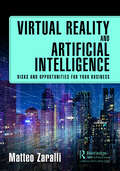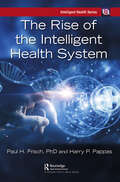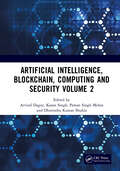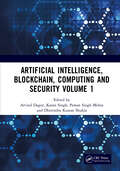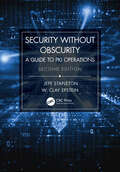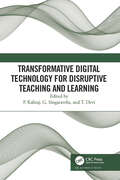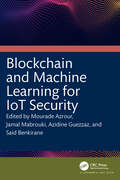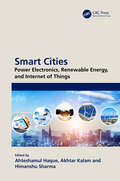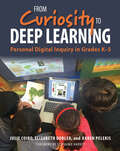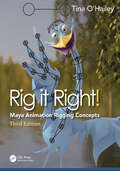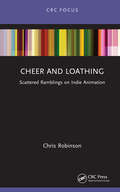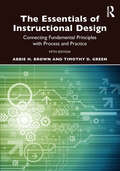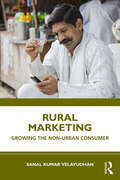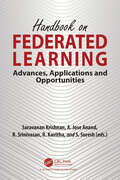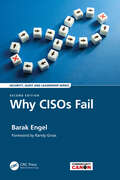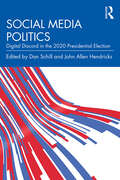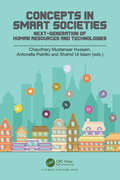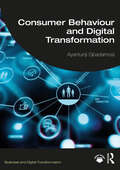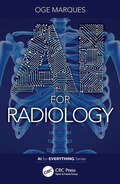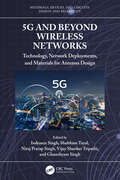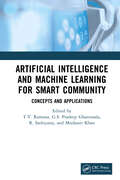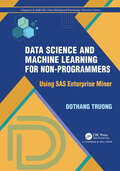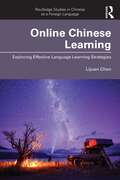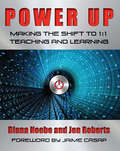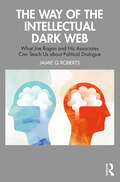- Table View
- List View
Virtual Reality and Artificial Intelligence: Risks and Opportunities for Your Business
by Matteo ZaralliTechnology is rapidly transforming the way people learn and train, and the integration of virtual reality (VR) and artificial intelligence (AI) could be the next big breakthrough. With the advent of Web 3.0 and the Metaverse, there are endless possibilities for creating immersive and engaging learning environments. However, there is also a need to address the risks and challenges that these technologies present.This book explores the risks and opportunities of VR and AI for coaching and training, with an eye toward the emerging trends of Web 3.0 and the Metaverse. Coaching and training have become increasingly important for companies seeking to develop and retain talent. With the advent of VR and AI technology, there is an opportunity to create immersive and engaging learning environments that could greatly enhance the learning experience. However, there are also risks associated with the use of these technologies, such as data privacy and cybersecurity.This book provides an in-depth analysis of the risks and opportunities of VR and AI for coaching and training, to help startup and business executives understand how to use these technologies responsibly and effectively. We need a new perspective. The book discusses the intersection of various major subjects and topics: business, innovation, technology, and philosophy in terms of critical thinking. The transition we are experiencing through this new Intelligent Revolution is very important, and soon everyone will witness the shift from e-learning to v-learning.
The Rise of the Intelligent Health System (Intelligent Health Series)
by Harry P. Pappas Paul H. Frisch"I recommend that all members of the health community read this book to obtain a real snapshot of how the Intelligent Health System is being transformed via new technologies." Chris Landon MD FAAP, FCCP, FRSM Clinical Associate Professor USC Keck School of Medicine Technology Development Center Laboratory and Studio The "Intelligent Health Pavilion" as demonstrated at the annual HIMSS Conference by the Intelligent Health Association is the impetus for this book. This book documents the remarkable journey of "Intelligent Health System" and the adoption of Innovative technologies. Many showcased in real time on the trade show floor and now in this book: "The Rise of the Intelligent Health System". In each chapter of this book, authors are expressing the immense potential of merging cutting-edge technology with the complex realm of patient care and safety. The informative chapters in this book delve deep into the unfolding story of how hospitals have evolved into interactive, intelligent environments, driven by real-time data and powered by artificial intelligence. In what seems like the blink of an eye, technology has completely transformed the way we live, work, and interact with the world around us. From smartphones to self-driving cars, ChatGPT, wireless technologies, wearables, and many other innovations are reshaping our society, pushing the boundaries of what was once considered impossible. However, nowhere is the impact of technology more profound than in the field of healthcare.
Artificial Intelligence, Blockchain, Computing and Security Volume 2: Proceedings of the International Conference on Artificial Intelligence, Blockchain, Computing and Security (ICABCS 2023), Gr. Noida, UP, India, 24 - 25 February 2023
by Karan Singh Pawan Singh Mehra Arvind Dagur Dhirendra Kumar ShuklaThis book contains the conference proceedings of ICABCS 2023, a non-profit conference with the objective to provide a platform that allows academicians, researchers, scholars and students from various institutions, universities and industries in India and abroad to exchange their research and innovative ideas in the field of Artificial Intelligence, Blockchain, Computing and Security. It explores the recent advancement in field of Artificial Intelligence, Blockchain, Communication and Security in this digital era for novice to profound knowledge about cutting edges in artificial intelligence, financial, secure transaction, monitoring, real time assistance and security for advanced stage learners/ researchers/ academicians. The key features of this book are: Broad knowledge and research trends in artificial intelligence and blockchain with security and their role in smart living assistance Depiction of system model and architecture for clear picture of AI in real life Discussion on the role of Artificial Intelligence and Blockchain in various real-life problems across sectors including banking, healthcare, navigation, communication, security Explanation of the challenges and opportunities in AI and Blockchain based healthcare, education, banking, and related industries This book will be of great interest to researchers, academicians, undergraduate students, postgraduate students, research scholars, industry professionals, technologists, and entrepreneurs.
Artificial Intelligence, Blockchain, Computing and Security Volume 1: Proceedings of the International Conference on Artificial Intelligence, Blockchain, Computing and Security (ICABCS 2023), Gr. Noida, UP, India, 24 - 25 February 2023
by Karan Singh Pawan Singh Mehra Arvind Dagur Dhirendra Kumar ShuklaThis book contains the conference proceedings of ICABCS 2023, a non-profit conference with the objective to provide a platform that allows academicians, researchers, scholars and students from various institutions, universities and industries in India and abroad to exchange their research and innovative ideas in the field of Artificial Intelligence, Blockchain, Computing and Security. It explores the recent advancement in field of Artificial Intelligence, Blockchain, Communication and Security in this digital era for novice to profound knowledge about cutting edges in artificial intelligence, financial, secure transaction, monitoring, real time assistance and security for advanced stage learners/ researchers/ academicians. The key features of this book are: Broad knowledge and research trends in artificial intelligence and blockchain with security and their role in smart living assistance Depiction of system model and architecture for clear picture of AI in real life Discussion on the role of Artificial Intelligence and Blockchain in various real-life problems across sectors including banking, healthcare, navigation, communication, security Explanation of the challenges and opportunities in AI and Blockchain based healthcare, education, banking, and related industries This book will be of great interest to researchers, academicians, undergraduate students, postgraduate students, research scholars, industry professionals, technologists, and entrepreneurs.
Security Without Obscurity: A Guide to PKI Operations
by Jeff Stapleton W. Clay EpsteinPublic Key Infrastructure (PKI) is an operational ecosystem that employs key management, cryptography, information technology (IT), information security (cybersecurity), policy and practices, legal matters (law, regulatory, contractual, privacy), and business rules (processes and procedures). A properly managed PKI requires all of these disparate disciplines to function together – coherently, efficiently, effectually, and successfully. Clearly defined roles and responsibilities, separation of duties, documentation, and communications are critical aspects for a successful operation. PKI is not just about certificates, rather it can be the technical foundation for the elusive "crypto-agility," which is the ability to manage cryptographic transitions. The second quantum revolution has begun, quantum computers are coming, and post-quantum cryptography (PQC) transitions will become PKI operation’s business as usual.
Transformative Digital Technology for Disruptive Teaching and Learning
by P. Kaliraj T. Devi G. SingaraveluGeneration Z students are avid gamers and are always on social media. Smart like their phones, they must be educated in a smart manner, which involves the use of digital tools. Transformative Digital Technology for Disruptive Teaching and Learning provides smart education solutions and details ways in which Gen Z learners can be educated. It covers such digital learning strategies as blended learning, flipped learning, mobile learning, and gamification. It examines creative teaching–learning strategies to encourage modern learners to learn more quickly. The book discusses ways to accelerate the capabilities of teaching and learning transactions. It also covers innovative teaching and learning processes to meet the challenges of digital learners.Starting with an overview of digital learning resources and processes as well as their advantages and disadvantages, the book then discusses such approaches and strategies as follows: Learner-oriented and learner-friendly approaches Blended learning Active learning Experiential learning Virtual learning Applications of Cloud Computing and Artificial Intelligence Gamification LMS challenges and techno-pedagogical issues for modern life As digital technology is disrupting teaching and learning, especially the skill development of students in the era of Industry 4.0 and 5.0, this is a timely book. It provides methods, approaches, strategies, and techniques for innovative learning and teaching. It discusses how to leverage new technology to enhance educators’ and learners’ abilities and performance. A comprehensive reference guide for educational researchers and technology developers, the book also helps educators embrace the digital transformation of teaching and learning.
Blockchain and Machine Learning for IoT Security
by Mourade Azrour, Jamal Mabrouki, Azidine Guezzaz, and Said BenkiraneThe Internet of Things (IoT) involves physical devices, cars, household appliances, and any other physical appliance equipped with sensors, software, and network connections to gather and communicate data. Nowadays, this technology is embedded in everything from simple smart devices, to wearable equipment, to complex industrial machinery and transportation infrastructures. On the other hand, IoT equipment has been designed without considering security issues. Consequently, there are many challenges in terms of protection against IoT threats, which can lead to distressing situations. In fact, unlike other technological solutions, there are few standards and guidelines governing the protection of IoT technology. Moreover, few users are aware of the risks associated with IoT systems. Hence, Blockchain and Machine Learning for IoT Security discusses various recent techniques and solutions related to IoT deployment, especially security and privacy. This book addresses a variety of subjects, including a comprehensive overview of the IoT, and covers in detail the security challenges at each layer by considering how both the architecture and underlying technologies are employed. As acknowledged experts in the field, the authors provide remediation solutions for impaired security, as well as mitigation methods, and offer both prevention and improvement suggestions. Key Features: Offers a unique perspective on IoT security by introducing Machine Learning and Blockchain solutions Presents a well-rounded overview of the most recent advances in IoT security and privacy Discusses practical solutions and real-world cases for IoT solutions in various areas Provides solutions for securing IoT against various threats Discuses Blockchain technology as a solution for IoT This book is designed to provide all the necessary knowledge for young researchers, academics, and industry professionals who want to understand the advantages of artificial intelligence technology, machine learning, data analysis methodology, and Blockchain for securing IoT technologies.
Smart Cities: Power Electronics, Renewable Energy, and Internet of Things
by Himanshu Sharma Akhtar Kalam Ahteshamul HaqueThis book discusses the integration of power electronics, renewable energy, and the Internet of Things (IoT) from the perspective of smart cities in a single volume. The text will be helpful for senior undergraduate, graduate students and academic researchers in diverse engineering fields including electrical, electronics and communication, and computers. The book: Covers the integration of power electronics, energy harvesting, and the IoT for smart city applications. Discusses concepts of power electronics and the IoT in electric vehicles for smart cities. Examines the integration of power electronics in renewable energy for smart cities. Discusses important concepts of energy harvesting including solar energy harvesting, maximum power point tracking (MPPT) controllers, and switch-mode power supplies (SMPS). Explores IoT connectivity technologies such as long-term evolution (LTE), narrow band NB-IoT, long-range (LoRa), Bluetooth, and ZigBee (IEEE Standard 802.15.4) for low data rate wireless personal communication applications. The text provides the knowledge about applications, technologies, and standards of power electronics, renewable energy, and IoT for smart cities. It will serve as an ideal reference text for senior undergraduate, graduate students and academic researchers in the fields of electrical engineering, electronics and communication engineering, computer engineering, civil engineering, and environmental engineering.
From Curiosity to Deep Learning: Personal Digital Inquiry in Grades K-5
by Julie Coiro Elizabeth Dobler Karen PelekisFrom Curiosity to Deep Learning: Personal Digital Inquiry in Grades K-5 reveals the powerful learning that results when you integrate purposeful technology into a classroom culture that values curiosity and deep learning. The centerpiece of this practical guide is Personal Digital Inquiry (PDI), a framework developed by Julie Coiro and implemented in classrooms by her co-authors, Elizabeth Dobler and Karen Pelekis. Clear, detailed examples offer ideas for K-5 teachers and school librarians to support their teaching.Personal emphasizes the significance of the personal relationship between teachers and students, and the role that students have in the learning process. Digital reflects the important role that digital texts and tools have come to play in both learning and teaching with inquiry. Inquiry lies at the core of PDI, because learners grow and change with opportunities to identify problems, generate personal wonderings, and engage in collaborative dialogue, making learning relevant and lasting.From Curiosity to Deep Learning: Personal Digital Inquiry in Grades K-5 shows you how to integrate inquiry with a range of digital tools and resources that will create a dynamic classroom for both you and your students.
Rig it Right!: Maya Animation Rigging Concepts
by Tina O'HaileyRig It Right! breaks down rigging so that you can achieve a fundamental understanding of the concept. The author will get you up and rigging with step-by-step tutorials covering multiple animation control types, connection methods, interactive skinning, BlendShapes, edgeloops, and joint placement, to name a few. The concept of a biped is explored as a human compared to a bird character allowing you to see that a biped is a biped and how to problem solve for the limbs at hand. Rig It Right! will take you to a more advanced level where you will learn how to create stretchy rigs with invisible control systems and use that to create your own types of rigs.This highly anticipated Third Edition features updated chapters and images, including new chapters on modeling with proper edgeloop (Rule #1!), how to Rig It Right then Rig it Fast with parallel processing, and new helpful scripts for evaluating your rig with the profiler tools.Key Features Hone your skills every step of the way with short tutorials and editable rigs that accompany each chapter (17+ rigs!!) Read "Tina’s 10 Rules of Rigging" and build the foundational knowledge needed to successfully rig your characters New content: Edgeloops for Good Deformation and Rigging for a Parallel World New scripts for evaluating your rigs’ performance Access the Support Materials and expand your newfound knowledge with editable rigs, exercises, and videos that elaborate on techniques covered in the book
Cheer and Loathing: Scattered Ramblings on Indie Animation (Focus Animation Ser.)
by Chris RobinsonOne of the most acclaimed writers in animation returns with this informal sequel to his previous books on indie animation, Unsung Heroes of Animation, Animators Unearthed, and Mad Eyed Misfits. In this collection, award-winning writer, Chris Robinson, looks at a wide range of films, topics (sex, censorship, cultural politics, programming, felt, gifs, VR, dogs) and filmmakers (Masaaki Yuasa, Xi Chen, Gil Alkabetz, Jacques Drouin, Bordo, Rosto, Joaquín Cociña, Cristóbal León, George Schwizgebel, Lizzy Hobbs, Andreas Hykade, Leah Shore, and many others). Eclectic, brief, fiery, and opinionated, Robinson’s gonzo-tinged writing will amuse, confuse, annoy, and maybe even inspire while, hopefully introducing readers to the wonders of independently-produced animation.
The Essentials of Instructional Design: Connecting Fundamental Principles with Process and Practice
by Timothy D. Green Abbie H. Brown• Provides an overview of the principles and practice of Instructional Design without placing emphasis on any one ID model. • Introduces the essential elements of instructional design to students who are new to ID or need a refresher while in training or professional practice. • Revised and updated to include new references, definitions, technologies, instructional formats, design approaches, and more while retaining the structure and contents of the previous edition.
Rural Marketing: Growing the Non-urban Consumer
by Sanal Kumar VelayudhanRural markets offer a sizable and resilient pool of consumers to organizations and marketers. This book offers a comprehensive understanding of the fundamentals of rural marketing that influence consumer behaviour within the framework of a rapidly changing economy. The book: - includes in-depth discussions on critical issues in rural markets as well as case-studies that examine their socio-cultural nuances, peculiarities, and their economic and technological environments; - looks at concepts that are unique to rural markets from the perspective of the buyer and the marketer and analyses buying behaviour and its influences as well as the pricing, value, and positioning of products by brands; - analyses emerging trends and the future of these markets and the introduction of digitization and ecommerce in rural areas; - offers marketing tools and a detailed understanding of rural markets for professionals working in small or low-income markets. The cutting-edge learning tools presented in this book will make it of interest to professionals, students, and researchers working in rural marketing and management, business and economics, management studies, business planning, and marketing.
Handbook on Federated Learning: Advances, Applications and Opportunities
by S. Suresh R. Srinivasan Saravanan Krishnan A. Jose Anand R. KavithaMobile, wearable, and self-driving telephones are just a few examples of modern distributed networks that generate enormous amount of information every day. Due to the growing computing capacity of these devices as well as concerns over the transfer of private information, it has become important to process the part of the data locally by moving the learning methods and computing to the border of devices. Federated learning has developed as a model of education in these situations. Federated learning (FL) is an expert form of decentralized machine learning (ML). It is essential in areas like privacy, large-scale machine education and distribution. It is also based on the current stage of ICT and new hardware technology and is the next generation of artificial intelligence (AI). In FL, central ML model is built with all the data available in a centralised environment in the traditional machine learning. It works without problems when the predictions can be served by a central server. Users require fast responses in mobile computing, but the model processing happens at the sight of the server, thus taking too long. The model can be placed in the end-user device, but continuous learning is a challenge to overcome, as models are programmed in a complete dataset and the end-user device lacks access to the entire data package. Another challenge with traditional machine learning is that user data is aggregated at a central location where it violates local privacy policies laws and make the data more vulnerable to data violation. This book provides a comprehensive approach in federated learning for various aspects.
Why CISOs Fail: The Missing Link In Security Management--and How To Fix It (Security, Audit and Leadership Series)
by Barak EngelReleased in 2017, the first edition of Why CISOs Fail reimagined the role of the Chief Information Security Officer in a new and powerful way. Written to be easily consumable by both security pros as well as everyone who must deal with them, the book explores the different realms in which security leaders fail to deliver meaningful impact to their organizations, and why this happens. Its central thesis—that security is primarily a human behavioral discipline rather than a technology one—has been gaining increased attention as a core tenet of the field, and the book was ultimately inducted into the cybersecurity canon as a leading book on security management.In this freshly updated edition, Barak Engel adds new sections that correspond with the chapters of the original book: security as a discipline; as a business enabler; in sales; in legal; in compliance; in technology; and as an executive function. He explores new ideas in each operational area, providing essential insights into emerging aspects of the discipline. He then proposes two critical concepts for security management—the concept of "digital shrinkage" and the transition from CISO to CI/SO—that together offer a new paradigm for any organization that wants to become truly successful in its security journey.Why CISOs (Still) Fail is delivered in Barak's conversational, humoristic style, that has attracted a global audience to this and his other book, The Security Hippie. As he notes, the book's goal is to entertain as much as to inform, and he dearly hopes that you have fun reading it.
Social Media Politics: Digital Discord in the 2020 Presidential Election
by John Allen Hendricks Dan SchillSocial media and social networking services are integrated into the American political process and have profoundly influenced political communication and participation. Social media platforms have transformed the political landscape by revolutionizing information dissemination, citizen engagement, and public opinion formation and change. Politicians use social media to communicate directly with voters in an unmediated and unfiltered manner. Comparatively, voters use social media to follow the latest messaging from politicians accompanied by demonstrating their support for particular politicians. This book is a comprehensive examination of the role of digital and social media in the 2020 U.S. presidential election. Political discourse during the 2020 election revealed political disharmony and a deep political division among vast swaths of Americans that was powered, in part, by social media. This book reveals how digital and social media have reshaped power dynamics by altering the relationships among citizens, politicians, and traditional media outlets, the emergence of new influencers, and the impact of online activism on policy agendas.This book, Social Media Politics, includes scholars with varied backgrounds and experience, using both quantitative and qualitative methodologies, from leading research institutions around the nation. Students, scholars, and practitioners will gain new knowledge to more clearly understand the role social media played in the 2020 presidential campaign.
Concepts in Smart Societies: Next-generation of Human Resources and Technologies
by Antonella Petrillo Chaudhery Mustansar Hussain Shahid Ul IslamWe live in a society driven by rapid and unpredictable changes. The concept of the “fourth industrial revolution” was introduced less than ten years ago - the more aware and reality oriented “smart factories”. By this we mean novelties in production technologies, enabling IT services and greater attention to energy consumption. Today, we are discussing the fifth stage in the evolution of society, the advent of the 5.0 company. This book outlines strategic lines and suggests future directions for the development of the "super smart society" which takes responsibility and ensures sustainability by adhering to new smart technologies and skills. The book is intended for a broad audience working in the fields of material science and engineering, energy, environment, etc. It is an invaluable reference source for researchers, academicians, students, industrial institutions, government and independent institutes, individual research groups and scientists working in the field of industrial applications of smart manufacturing design.
Consumer Behaviour and Digital Transformation (Business and Digital Transformation)
by Ayantunji GbadamosiThis comprehensive textbook explores how technological developments and emerging technologies impact on, and engage with, consumer behaviour and decision making globally. The book will enable readers to develop a coherent understanding of the basic underpinnings of consumer behaviour as they relate to individual and group-oriented consumption decisions, offering insight into how consumer behaviour, contemporary real-life situations, and digital technology are inextricably linked.Key learning objectives, exercises and activities, boxed examples and analytical frameworks facilitate and enrich students’ learning. Each chapter includes ‘pause, plan, and practice (PPP)’ activities, as well as real-life case studies exploring digital consumption, digital consumer experiences, and digital trends across industries, from global companies such as Nike and McDonald’s to the digital transformation of SMEs. Combining a thorough examination of traditional theory with a fresh approach to the impact of digital transformation on consumer behaviour, this textbook should be core reading for advanced undergraduate and postgraduate students studying Consumer Behaviour, Consumer Psychology, Customer Experience Management, and Digital Marketing.This book will be accompanied by online resources for the use of instructors, including PowerPoint slides and a test bank.
AI for Radiology (AI for Everything)
by Oge MarquesArtificial intelligence (AI) has revolutionized many areas of medicine and is increasingly being embraced. This book focuses on the integral role of AI in radiology, shedding light on how this technology can enhance patient care and streamline professional workflows. This book reviews, explains, and contextualizes some of the most current, practical, and relevant developments in artificial intelligence and deep learning in radiology and medical image analysis. AI for Radiology presents a balanced viewpoint of the impact of AI in these fields, underscoring that AI technologies are not intended to replace radiologists but rather to augment their capabilities, freeing professionals to focus on more complex cases. This book guides readers from the basic principles of AI to their practical applications in radiology, moving from the role of data in AI to the ethical and regulatory considerations of using AI in radiology and concluding with a selection of resources for further exploration. This book has been crafted with a diverse readership in mind. It is a valuable asset for medical professionals eager to stay up to date with AI developments, computer scientists curious about AI’s clinical applications, and anyone interested in the intersection of healthcare and technology.
5G and Beyond Wireless Networks: Technology, Network Deployments, and Materials for Antenna Design (Materials, Devices, and Circuits)
by Ghanshyam Singh Shubham Tayal Vijay Shanker Tripathi Indrasen Singh Niraj Pratap Singh5G and Beyond Wireless Networks: Technology, Network Deployments, and Materials for Antenna Design offers a comprehensive overview of 5G and beyond 5G wireless networks along with emerging technologies that support the design and development of wireless networks. It also includes discussions on various materials used for practical antenna design which are suitable for 5G, beyond 5G applications, and cell-free massive MIMO systems.The book discusses the latest techniques used in 5G and beyond 5G (B5G) communication, such as non-orthogonal multiple access (NOMA), device-to-device (D2D) communication, 6G ultra-dense O-RAN, rate-splitting multiple access (RSMA), simultaneous wireless information and power transfer (SWIPT), massive multiple input multiple output (mMIMO), and cell-free massive MIMO systems, which are explained in detail for 5G and beyond cellular networks. The description of NOMA and their benefit for 5G and beyond networks is also addressed along with D2D communication for next generation cellular networks. RSMA technique is also explained for 6G communication. Detailed descriptions for the design and development of 5G and beyond networks over various techniques are included. The materials specification to design antenna for 5G application are also given.The role of metalens in designing effective antennas and material specifications for 5G applications is explained in this book. Apart from the above emerging topics, this book also gives ideas about intelligent communication, Internet of Multimedia Things (IOMT), millimeter-wave MIMO-UFMC, and fog computing cloud networks. The last chapter gives details about the legal frameworks for 5G technology for responsible and sustainable deployment. Overall, this book may benefit network design engineers and researchers working in the area of next generation cellular networks.The contents of this book will be helpful for young researchers and master students, and network design engineers who are working in the area of next generation cellular networks.
Artificial Intelligence and Machine Learning for Smart Community: Concepts and Applications
by R. Sathiyaraj T. V. Ramana G. S. Pradeep Ghantasala Mudassir KhanIntelligent systems are technologically advanced machines that perceive and respond to the world around them. Artificial Intelligence and Machine Learning for Smart Community: Concepts and Applications presents the evolution, challenges, and limitations of the application of machine learning and artificial intelligence to intelligent systems and smart communities. Covers the core and fundamental aspects of artificial intelligence, machine learning, and computational algorithms in smart intelligent systems Discusses the integration of artificial intelligence with machine learning using mathematical modeling Elaborates concepts like supervised and unsupervised learning, and machine learning algorithms, such as linear regression, logistic regression, random forest, and performance evaluation matrices Introduces modern algorithms such as convolutional neural networks and support vector machines Presents case studies on smart healthcare, smart traffic management, smart buildings, autonomous vehicles, smart education, modern community, and smart machines Artificial Intelligence and Machine Learning for Smart Community: Concepts and Applications is primarily written for graduate students and academic researchers working in the fields of computer science and engineering, electrical engineering, and information technology. Seasonal Blurb: This reference text presents the most recent and advanced research on the application of artificial intelligence and machine learning on intelligent systems. It will discuss important topics such as business intelligence, reinforcement learning, supervised learning, and unsupervised learning in a comprehensive manner.
Data Science and Machine Learning for Non-Programmers: Using SAS Enterprise Miner (Chapman & Hall/CRC Data Mining and Knowledge Discovery Series)
by Dothang TruongAs data continues to grow exponentially, knowledge of data science and machine learning has become more crucial than ever. Machine learning has grown exponentially; however, the abundance of resources can be overwhelming, making it challenging for new learners. This book aims to address this disparity and cater to learners from various non-technical fields, enabling them to utilize machine learning effectively. Adopting a hands-on approach, readers are guided through practical implementations using real datasets and SAS Enterprise Miner, a user-friendly data mining software that requires no programming. Throughout the chapters, two large datasets are used consistently, allowing readers to practice all stages of the data mining process within a cohesive project framework. This book also provides specific guidelines and examples on presenting data mining results and reports, enhancing effective communication with stakeholders. Designed as a guiding companion for both beginners and experienced practitioners, this book targets a wide audience, including students, lecturers, researchers, and industry professionals from various backgrounds.
Online Chinese Learning: Exploring Effective Language Learning Strategies (Routledge Studies in Chinese as a Foreign Language)
by Lijuan ChenOnline Chinese Learning aims to investigate the types of language learning strategies (LLSs) that online Chinese learners use across asynchronous and synchronous learning environments in different learning contexts.This book examines how the use of language learning strategies by online Chinese learners is influenced by the interactants; the characteristics of the specific learning context; and selected individual learner characteristics. This book will provide: (1) new and detailed information about students’ LLS use in online Chinese learning; (2) insights into how individual students adopt LLSs and technological tools to solve learning problems in various learning contexts; (3) an exploration of factors influencing LLS use; and (4) recommendations regarding LLS adoption, use, and training.This book will be a valuable resource for university instructors in languages, language teaching methods, and second language acquisition, as well as researchers in languages, linguistics, and language learning and teaching.
Power Up: Making the Shift to 1:1 Teaching and Learning
by Diana Neebe Jen RobertsWherever you are on the path to 1:1 teaching and learning, you need a guide that can help you make the best use of the powerful technology available in today's classrooms. In Power Up: Making the Shift to 1:1 Teaching and Learning, Diana Neebe and Jen Roberts draw on research and their extensive experience working with teachers across subject areas and grade levels to share the keys to success when teaching with a computer or tablet for every student. This is the book secondary teachers need to understand the changes in pedagogy, planning, classroom organization, time management, and collaboration that will help them be successful in a 1:1 environment. Whether providing immediate and detailed feedback to student writers, giving voice to quiet learners, or creating more time for actual work in a jam-packed school day, Neebe and Roberts show teachers how communication, differentiation, and other effective practices can be powered up with personalized technology. Throughout the book, Neebe and Roberts coach teachers through their initial concerns about technology integration, offer advice about avoiding common problems, and encourage innovation. Using detailed classroom examples, questions, and suggestions, they provide a framework for shaping the transformation of a traditional classroom into a student-centered, technology-rich learning environment. Readers will come away with a clear sense of how a fully implemented 1:1 classroom operates. Power Up makes the transition to 1:1 a manageable and exciting journey. It's a key part of supporting teachers and ensuring the success of your 1:1 program.
The Way of the Intellectual Dark Web: What Joe Rogan and His Associates Can Teach Us about Political Dialogue
by Jamie Q RobertsRoberts presents a rigorous and accessible assessment of the Intellectual Dark Web’s origins, shared philosophy, cultural importance, and limitations. Since the mid-2010s, the Intellectual Dark Web (IDW) has been an unprecedented cultural and intellectual phenomenon. Using primarily podcasts and YouTube videos, a new generation of public intellectuals has appeared, loosely coalesced, and gained a vast global audience. This movement has encompassed a range of individuals, notably Joe Rogan, Jordan Peterson, Eric and Bret Weinstein, Ben Shapiro, Heather Heying, and Sam Harris. Other names more broadly associated with the grouping have included Steven Pinker, Jonathan Haidt, Elon Musk, Niall Ferguson, and Stephen Fry. There is a sprawling and ever-growing list of those who have appeared on IDW podcasts and videos, started their own podcasts along similar lines, and share a general ethos. It is a dispersed movement, but a significant one, given the reach of these various online outlets is in the millions globally. Roberts draws together and synthesises the core ideas espoused by the members of this movement and critically assesses its origins, coherence, and the impact it has had on politics and public discourse. He asks – to what extent has the IDW lived up to its professed goal of moving beyond polarisation and radicalisation? An insightful read both for followers of the IDW looking for a coherent and critical overview and for students of popular culture looking to understand this massive but decentralised popular intellectual movement.
